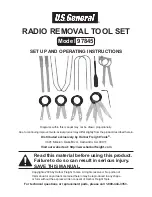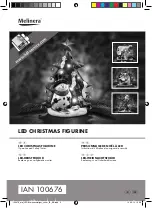
TLS Magnetostrictive Probes International Installation Guide
Health And Safety
3
The Magnetostrictive Probe that is part of the TLS Monitoring System is equipment Category 1 intended to be
installed in a Zone 0 hazardous location. Extreme care must be taken when determining the suitability of the
installation conditions and operation of the TLS Monitoring System. Procedures for installing either in a process
connection or riser pipe are detailed beginning on page 13. At least the following items must be considered and will
aid in the determination if a probe is to be installed in a process connection or riser pipe:
1.
Equipotential grounding of the installation site,
2.
Minimizing static hazards associated with the underground storage of flammable liquids, and
3.
Protection of the system against lightning strikes and any other source of possible electrical surges caused by
electrical railway systems, high voltage direct current facilities and the like.
EQUIPOTENTIAL GROUNDING
Consult any local regulations prior to installing a Magnetostrictive Probe into any tank. Veeder-Root supplies
approved process connections for installations where direct connection between the probe body and tank structure
is required (see Probe Installation Using Process Connection instructions below).
The intrinsically safe circuit in the TLS Monitoring System is derived from a fuse protected zener diode intrinsic safety
barrier. This type of explosion protection requires that the intrinsically safe electric circuit is referenced to the safety
ground associated to the mains circuit. If the site has a submersible pump (DIN/EN 15268) connected to the same
mains safety ground as the TLS Monitoring System Console and it is installed in a metallic riser of a metallic storage
tank, the zener diode barrier must be referenced to the same earth (safety) ground.
MINIMIZATION OF ELECTROSTATIC HAZARDS
Consult any local regulations prior to installing a Magnetostrictive Probe into any tank. Veeder-Root supplies
approved process connections for installations where direct connection between the probe body and tank structure
is required (see Probe Installation Using Process Connection instructions below).
The magnetostrictive probe housing complies with the 500 volt electrical strength requirements in IEC/EN 60079-
11. In addition, the probe housing provides an electrostatic dissipative path to the zener diode barrier earth ground
that must be referenced to the common grounding system. The electrostatic resistive path is less than 1 megohm.
All TLS Consoles provide an alarm if either of the two wires to the magnetostrictive probe is disconnected or short
circuited due to a malfunction.
If a probe must be serviced or replaced, observe any required relaxation time prior to opening any covers and
removing the probe.
LIGHTNING AND SURGE PROTECTION
Consult any local regulations prior to installing a Magnetostrictive Probe into any tank. Local rules or regulations may
require surge arrestors when installing equipment that crosses from a less restrictive zone, e.g., zone1 to zone 0
independent of the risk assessment. When required Veeder-Root can supply appropriate surge protection devices.
In locations where the intrinsically safe cables or circuits are considered to be at risk of developing hazardous
potential differences within Zone 0, an external surge protection device may be needed. Perform the lightning risk
analysis to determine if surge protection is required, and if necessary, the surge protector shall be installed in
accordance with IEC/EN 60079-25 and IEC/EN 60079-14. Reference Figure 14 and Figure 15 for mounting
locations for a surge protector.
When they are deemed necessary, Veeder-Root requires the installation of external surge protection devices that are
classified as simple apparatus only. Only gas-discharge type surge protectors that comply with Clause 12 of IEC/EN
60079-25 are acceptable. Additional installation requirements for surge protection devices are defined in Clause
12.3 of standard IEC/EN 60079-14.
The Surge Risk Protection Assessment checklist (SRPA) is available on the Veeder
-
Root Tech Docs CD and on our
website at
http://www.veeder.com/page/Probe_Manuals
An example of the SRPA appears in Appendix A of this
manual.
EC-TYPE CERTIFICATES FOR AN INTRINSICALLY SAFE SYSTEM
TLS Monitoring Systems are installed according to the conditions specified in the applicable Certificates. ATEX
Certificate Number DEMKO 06 ATEX 137480X and IECEx ULD 08.0002X are referred to as the system certificate
or parent certificate for all of the equipment in a TLS Monitoring System.








































